Music as Medicine
Cellist Yo-Yo Ma Talks Music, Science
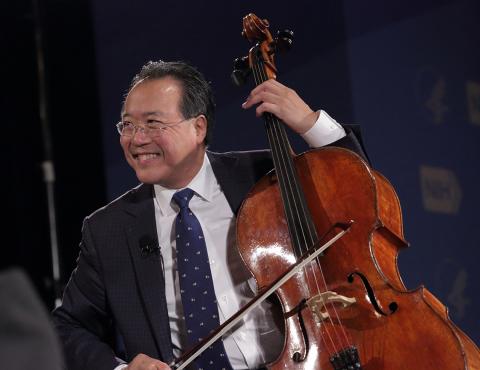
Photo: Ernie Branson
Something profound happens in the brain when we enjoy music. It draws us in, time and again, rousing our emotions. And it has no boundaries. Music can transport us to different moods, experiences and cultures.
Renowned cellist Yo-Yo Ma explored how music intersects with science and culture during a casual and witty conversation with NIH director Dr. Francis Collins at the recent annual J. Edward Rall Cultural Lecture.
While it undoubtedly takes talent and persistence to master playing a musical instrument, Ma divulged his scientific secret behind becoming a virtuoso who can play all six Bach solo cello suites from memory. “You learn what you need to learn by heart before you’re 20,” he quipped.
Ma, 61, started playing cello at age 4. After more than a half century of performing, he’s grateful to play music as his life’s work.
“I assume maybe everybody in this room is doing what they’re doing because something got them really excited at some point and they wanted more,” Ma told Collins. “Was it an experiment in fourth grade? Was it a teacher that opened up nature to you? Or was it something you solved at a certain point and got so much pleasure out of it that you wanted to do more?”
That desire for more also attracts us to music, especially in the way it brings us to different states of mind. To demonstrate, Ma picked up his 1712 Davidov Stradivarius cello and played part of a prelude to a Bach cello suite.
“The piece doesn’t make us feel excited,” Ma said. “The patterns, with note changes at irregular intervals, suggest calm and the idea of infinite variety.” The audience absorbed this idea of infinity—in the sense that they didn’t want his playing to end. Nor did Collins.
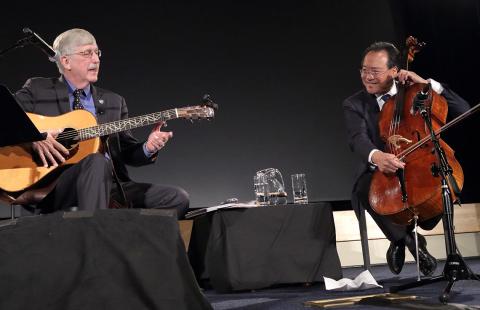
Photo: Ernie Branson
“Don’t put that away,” implored Collins as Ma laid down his cello. Collins asked, after all these years of performing, “Are you ever tempted to tinker with the Bach suites?”
“I think of notes as code,” said Ma. “Sometimes the code is so good, it works, but then you have to translate it through engineering and into physical space.”
Even skilled musicians can learn a new trick. Ma recounted meeting someone in the Boston Symphony Orchestra who suggested that all down bows should be up bows. While playing at a recent festival, he took the suggestion and liked the result.
“It was a simple thing but a massive recalculation that makes one part of your brain go crazy,” Ma said. “Some [small] changes make a big difference.”
There’s a science behind the brain’s reaction to music. The auditory cortex and other parts of the brain are wired for music, said Collins. While a person is enjoying music that is particularly moving, brain cells in the ventral striatum release dopamine, a neurotransmitter associated with pleasure, giving us literal chills.
“I’ve been thinking lately that music in some ways is something that was created as a societal pill,” said Ma.
“But sometimes the pill tastes bitter when it’s something we’re not familiar with,” said Collins. “What happens when everyone’s idea of what sounds good is not coherent?”
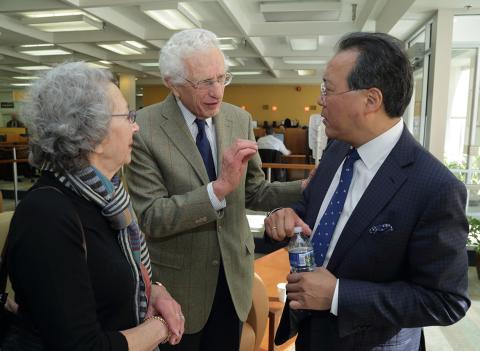
Photo: Ernie Branson
Ma answered with his cello. He played a scale that sounded out of tune to us because it was Persian. He then played a melody based on that scale. He said, “You’ve taken what was strange and out of tune and slightly ugly into the realm of ‘Oh my gosh, that’s beautiful.’”
Nearly 20 years ago, Ma founded the Silk Road Ensemble, featuring dozens of musicians who perform music from communities along the ancient Silk Road trade route that connected Europe to East Asia. His interest in uniting musical cultures grew out of his own experience. Born to Chinese parents living in Paris, he moved to the United States with his family when he was a child.
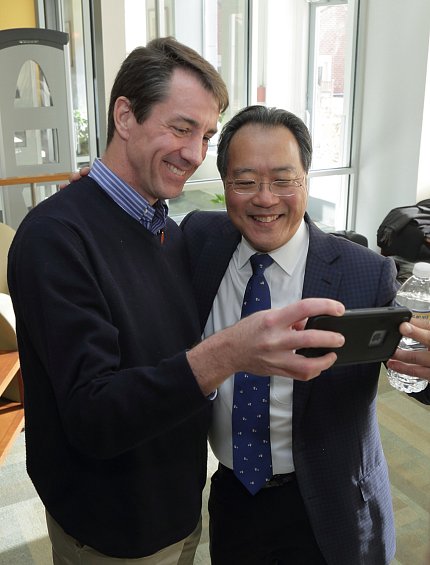
Photo: Ernie Branson
“I’m an immigrant,” he said. “It means you arrive from someplace you know to a place you don’t know.”
Ma said he’s long been fascinated with the idea of something foreign evolving into something familiar that eventually becomes part of our psyche. Collins said that also happens a great deal in science.
“The dream of most scientists is to discover something that upends current dogma about some aspect of life science that everyone always accepted,” said Collins. “Those big shifts require compelling evidence. People don’t necessarily want to stop listening to the music of science that they were familiar with and listen to a new tune.”
Great improvements, said Ma, can come from collaboration. He said his cello was crafted in Cremona, Italy, at a time when apprenticeships were popular and the quality of instruments peaked, between 1695 and 1735. But then instrument makers around the world began competing for business and keeping secrets.
“There’s a lesson here about science, I think,” interjected Collins.
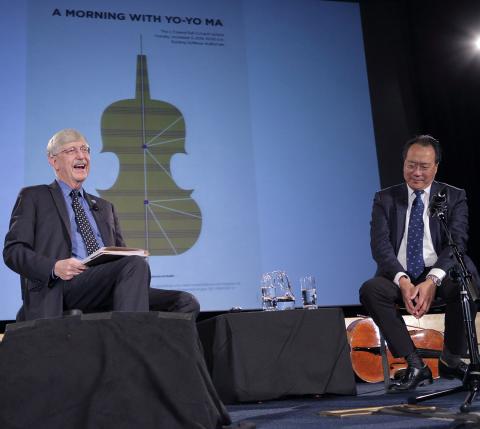
Photo: Ernie Branson
In the ensuing two centuries, Ma said, the quality of instruments plummeted. In the 1970s, however, apprenticeships resumed around the world; knowledge flowed and the quality of instruments dramatically improved.
At the end of their enlightening dialogue, Collins chose a Civil War-era song for a duet. Its chorus summed up the sentiments of the morning’s conversation as Collins sang, “It sounds an echo in my soul; how can I keep from singing?”
As a song or symphony unfolds, it can take us on a musical journey somewhere new or to somewhere familiar and comforting, evoking a range of moods. Said Ma, “Philosophically, if you go deep enough into any one [musical] code, you can discover the universe.”
